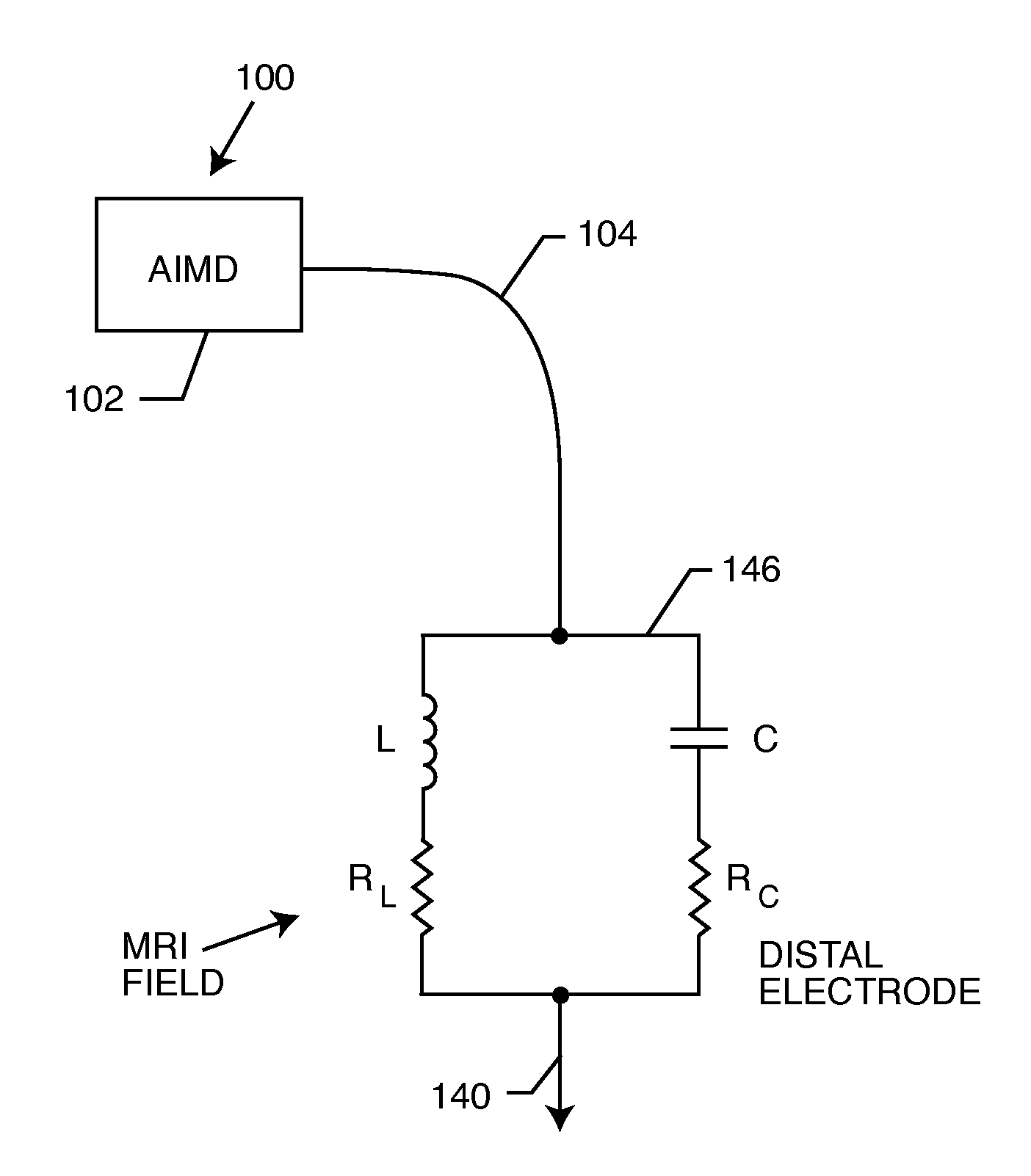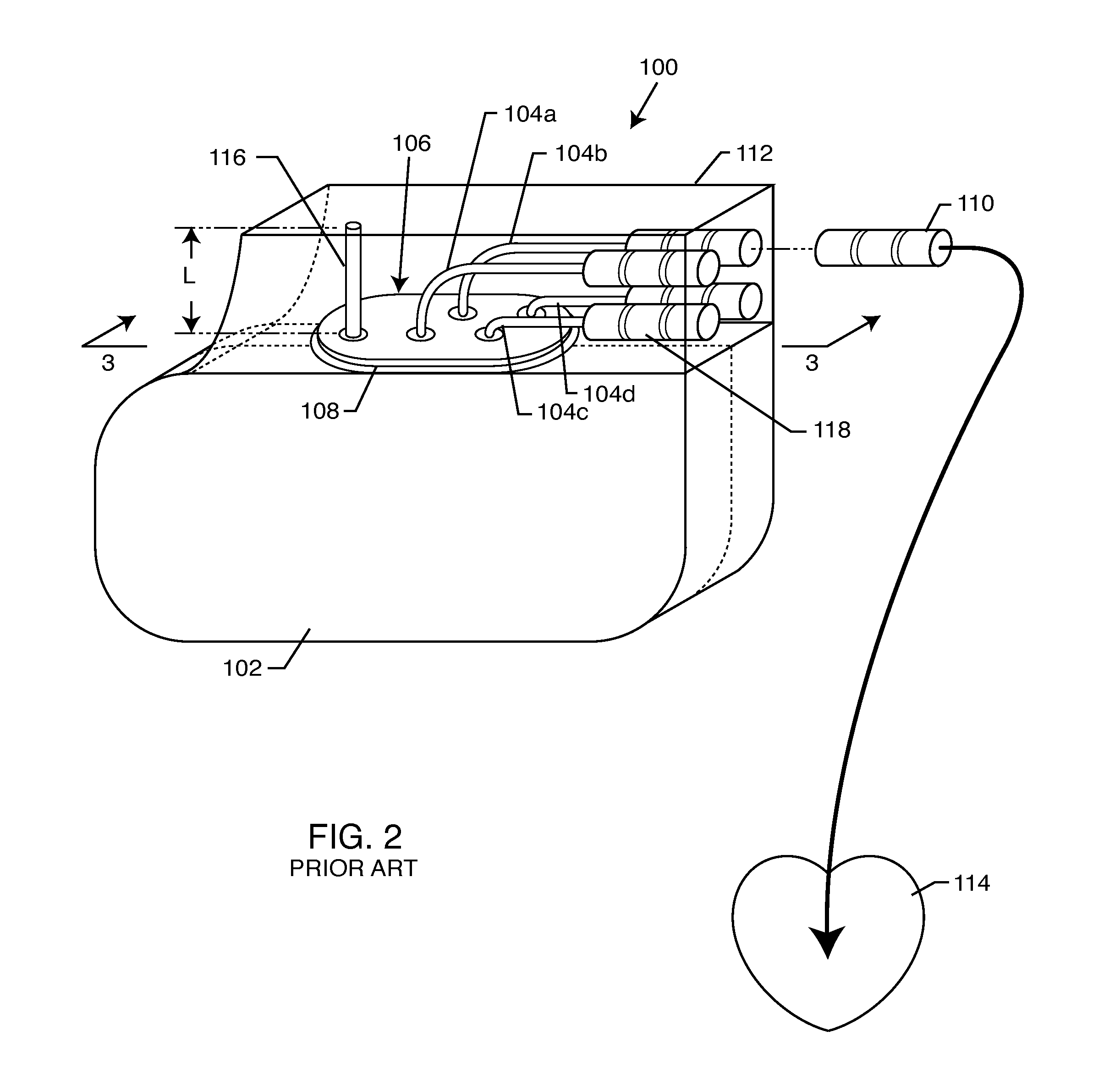[0019]The present invention comprises resonant tank circuits / bandstop filters to be placed at one or more locations along the active implantable
medical device (AIMD)
lead system, including its distal Tip. These bandstop filters prevent current from circulating at selected frequencies of the medical therapeutic device. For example, for an MRI
system operating at 1.5 Tesla, the pulse RF frequency is 64 MHz. The novel bandstop filters of the present invention can be designed to resonate at 64 MHz and thus create an open circuit in the implanted
lead system at that selected frequency. For example, the bandstop filter of the present invention, when placed at the distal TIP, will prevent currents from flowing through the distal TIP, prevent currents from flowing in the implanted leads and also prevent currents from flowing into
body tissue. It will be obvious to those skilled in the art that all of the embodiments described herein are equally applicable to a wide range of other active implantable medical devices, including deep brain stimulators,
spinal cord stimulators, cochlear implants, ventricular assist devices, artificial hearts,
drug pumps, and the like. The present invention fulfills all of the needs regarding reduction or
elimination of undesirable currents and associated heating in implanted lead systems.
[0025]In the preferred embodiment, the overall
Q factor of the bandstop filter is selected to balance impedance at the selected frequency versus
frequency band width characteristics. More specifically, the Q of the inductor is relatively maximized and the Q of the capacitor is relatively minimized to reduce the overall Q of the bandstop filter. The Q of the inductor is relatively maximized by minimizing the parasitic
resistive loss in the inductor, and the Q of the capacitor is relatively minimized by raising its
equivalent series resistance (ESR) of the capacitor (or by adding resistance or a
resistive element in series with the capacitor element of the
bank stop tank filter). This reduces the overall Q of the bandstop filter in order to broaden its 3 dB points and thereby attenuate current flow through the lead along a range of selected frequencies. In AIMD or external medical device applications, the range of selected frequencies includes a plurality of MRI pulsed frequencies.
[0026]The
equivalent series resistance of the capacitor is raised by any of the following: reducing thickness of
electrode plates in the capacitor; using higher resistivity capacitor
electrode materials, providing apertures, gaps, slits or spokes in the
electrode plates of the capacitor; providing separate discrete resistors in series with the capacitor; utilizing resistive electrical attachment materials to the capacitor; or utilizing capacitor
dielectric materials that have high
dielectric loss tangents at the selected frequency. Methods of using higher resistivity capacitor electrode materials include, for example, using
platinum instead of silver electrodes.
Platinum has a higher volume resistivity as compared to pure silver. Another way of reducing capacitor electrode plate resistivity is to add
ceramic powders to the electrode ink before it is silk screened down and fired. After firing, this has the effect of separating the conductive electrode portions by insulative
dielectric areas which increases the overall resistivity of the electrode plate.
[0027]As defined herein, raising the capacitor ESR includes any or all of the above described methods of adding resistance in series with the capacitive element of the bandstop filter. It should be noted that deliberately raising the capacitor ESR runs counter to conventional / prior art capacitor technologies. In fact, capacitor manufacturers generally strive to build capacitors with as low an ESR as possible. This is to minimize
energy loss, etc. It is a feature of the present invention that capacitor Q is raised in a controlled manner in the tank filter circuit in order to adjust its Q and adjust the bandstop frequency width in the range of MRI pulsed frequencies.
[0030]The overall Q of the tank filter circuit may be reduced by increasing the Q of the inductor and reducing the Q of the capacitor. In this regard, minimizing
resistive loss in the inductor maximizes the Q of the inductor, and raising the
equivalent series resistance of the capacitor minimizes the Q of the capacitor.
[0031]The net effect is to reduce the overall Q of the tank filter circuit which widens the bandstop width to attenuate current flow through the lead along a range of selected frequencies. As discussed herein, the range of selected frequencies may include a plurality of MRI pulse frequencies.
 Login to View More
Login to View More  Login to View More
Login to View More 


